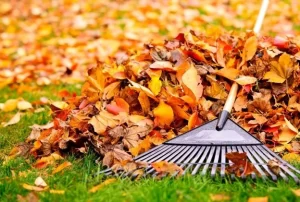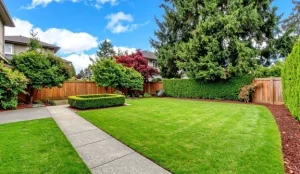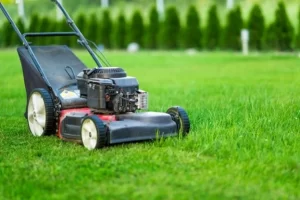Creating a grill-safe outdoor space is essential not only for entertaining but also for protecting your property from fire hazards. As grilling becomes a cherished part of modern backyard living, fire prevention must go beyond the barbecue setup and extend into your entire landscaping design.
Your outdoor space, whether it’s a small porch, a cozy patio, or a sprawling yard, can quickly become a fire risk if not properly planned and maintained. Uncontrolled dry foliage, poorly placed grills, flammable mulch, and tightly packed plants create a recipe for disaster when embers escape. Integrating fire-resistant vegetation, non-flammable hardscaping, and maintaining adequate defensible space are essential steps in creating a safe and functional environment for family and guests.

This guide outlines how to incorporate fire-resistant plants, strategic grill placement, non-combustible materials like gravel and concrete, and intelligent landscape design techniques to significantly reduce wildfire risk—especially in dry climates prone to extreme heat and wind.
Whether you’re upgrading your patio, converting a neglected backyard into a modern retreat, refreshing your front yard with sustainable features, or planning a commercial landscaping installation for a business or public facility, the principles in this guide apply to properties of all sizes. From urban rooftops to suburban homes and rural estates, a grill-safe outdoor space offers peace of mind, improves curb appeal, and enhances both safety and style.
Let’s explore how thoughtful landscaping, proper maintenance, and fire-conscious design can help you protect your home, create inviting outdoor areas, and promote long-term sustainable landscaping practices.
Fire-Resistant Plants: Nature’s Defense in Sustainable Landscaping
What Makes a Plant Fire-Resistant?
A fire-resistant plant has high moisture content, low resin or oil, and thick, waxy leaves. These traits slow ignition and flame spread. Many native species are ideal for this role, having evolved to withstand local conditions with minimal maintenance. Using these in your sustainable landscaping design supports habitat preservation and reduces water needs.
When selecting these fire-resistant plants, consider incorporating them into layered planting zones that separate high-risk areas—like grill stations or wooden fences—from your home and other structures. Pairing native species with gravel pathways, stone borders, or retaining walls can further compartmentalize your yard, acting as both functional firebreaks and attractive design elements. Additionally, placing these plants in strategic locations throughout your landscape enhances drainage, reduces soil erosion, and contributes to a more cohesive, sustainable landscape design.
Top Fire-Resistant Shrubs and Groundcovers
- Sedum, creeping thyme, and wildflower groundcovers thrive in sunny areas with minimal watering needs.
- Yucca is an excellent fire-wise shrub for open space and yard edges.
- Mondo grass and sod offer low-profile greenery that doubles as a cooling groundcover near grills and porches.
Integrating these into your garden design creates a layered, beautiful landscaping plan that works as a living firebreak.
Smart Tree Selection for Fire-Safe Landscaping and Shade
Incorporating fire-resistant trees into your landscape design provides a valuable combination of aesthetic appeal, functional shade, and critical fire mitigation. These trees act as natural barriers that can slow the spread of flames, especially when chosen and maintained with intention. Ideal species such as maple, bald cypress, and live oak have thick bark, high internal moisture content, and lower concentrations of volatile oils—traits that make them significantly more resilient to heat and fire. Unlike invasive species like pine or eucalyptus, which ignite quickly and release embers, these trees are less likely to contribute to the intensity or spread of a wildfire.
For maximum benefit, place fire-resistant trees with consideration to space, drainage, and airflow. Avoid clustering canopies, and ensure branches are pruned regularly to prevent ladder fuels from forming. Maintain vertical clearance between the ground and lowest branches, and horizontal spacing from your home, roof, fence, and any other combustible structures. In addition to enhancing your outdoor space, strategically placed trees help regulate temperatures, protect soil from erosion, and provide vital shelter for local wildlife habitat—all while contributing to more resilient, sustainable landscaping.
Grill Placement and Landscaping Strategies for Fire Mitigation
Proper Placement and Safe Distances
Always place your grill on a concrete or gravel surface to ensure a safe and stable foundation that won’t ignite under high temperatures or stray embers. These non-combustible materials provide excellent thermal resistance and support proper drainage, making them ideal for high-traffic grilling zones. Maintain a clearance of at least 10 to 20 feet between the grill and any flammable structures, such as your home, wooden fence, porch, dense vegetation, or overhanging roof features. This buffer zone is critical for reducing heat transfer, minimizing the spread of flames, and protecting nearby walls and architectural elements from damage.
In sustainable landscaping, this approach also contributes to better airflow and temperature regulation across your outdoor space. Creating intentional open space zones around high-risk areas like grills or fire pits disrupts the continuity of flammable materials, which is key to stopping fire progression. Integrating this strategy with features like stone borders, retaining walls, or pergolas built from fire-resistant materials not only enhances safety but also adds structure and visual harmony to your landscape design.
Defensible Space Around the Grill
Surround your grill with a well-defined buffer zone made of non-combustible materials such as stone, gravel, or decomposed granite to create a dedicated safety perimeter that prevents fire from easily spreading to nearby plants, structures, or furniture. These materials not only resist ignition but also enhance drainage and reduce soil compaction, which supports the long-term health of your surrounding landscape. This design element is especially important in sustainable landscaping, where the goal is to balance aesthetics, function, and safety.
Beyond reducing flammable contact, this clear buffer allows for safe movement and unobstructed emergency access in case a fire needs to be quickly contained. To increase functionality and comfort, consider adding a pergola constructed from metal or fire-treated wood. This structure provides essential shade for daytime grilling while resisting combustion and maintaining an open-air flow that helps dissipate heat. Integrating a pergola with nearby retaining walls, stone benches, or a fountain can create a cohesive and attractive grilling hub in your backyard or commercial landscaping plan—all while keeping fire risk to a minimum.
Using Non-Combustible Materials in Hardscaping
Hardscaping forms the core of a fire-safe landscape. Recommended non-combustible materials include:
- Concrete patios and walkways
- Gravel paths and retaining walls
- Stone borders and fountains
These durable surfaces enhance drainage, reduce flammable buildup, and contribute to the visual harmony of your yard or commercial landscaping project.
Mulch, Soil, and Landscaping Foliage Management
Mulch Selection Tips
Avoid combustible mulch such as bark near your grill. Instead, use gravel, stone chips, or decomposed granite. These promote safe soil coverage and moisture retention while lowering flame spread risk.
Managing Dry Foliage and Plant Waste
- Regularly prune dead branches and overgrowth.
- Remove pests or disease-damaged plants that may dry out and become flammable.
- Store trimmings and leaves in closed, metal bins.
- Monitor for seed accumulation, which may ignite in high heat.
Fire-safe landscaping maintenance is a key component of overall home improvement and safety.
Sustainable Landscaping Maintenance Checklist
- Inspect irrigation for leaks or low pressure; efficient water usage keeps plants hydrated and reduces risk.
- Sweep curbs, porches, and walls of debris regularly.
- Inspect mulch and replenish only with non-combustible options.
- Replace aging grill parts or surfaces to maintain heat containment.
- Use long-handled tools when cleaning or maintaining fire zones.
Routine care supports your investment and extends the life of your natural landscaping features.
Professional Help: Landscapers and Fire Safety Experts
Certified landscapers and sustainable landscaping design professionals can assess your property and help:
- Identify flammable zones
- Choose fire-resistant plants, trees, and mulch
- Install or upgrade patios, retaining walls, and drainage
- Develop habitat-friendly plans that align with garden design goals
Their guidance ensures compliance with local codes and enhances your home improvement project’s safety and value.
Frequently Asked Questions: Landscaping Around Grills
1. What types of plants are best near grills?
Use fire-resistant, low-resin plants like succulents, wildflowers, or native species like sage and yarrow.
2. Can I combine combustible and non-combustible materials?
Yes, but keep non-combustible materials near grills, and separate them with stone borders or metal edging.
3. How do I create defensible space in small yards?
Focus on vertical spacing, remove dry foliage, and replace mulch with gravel or concrete elements.
4. What’s a safe mulch option?
Choose decomposed granite, stone, or gravel—never bark or shredded wood in high-heat areas.
Conclusion: Fire-Smart Landscaping for a Safer, Beautiful Outdoor Space
A well-planned landscaping design combines form, function, and fire prevention. With thoughtful choices—native plants, strategic grill layout, fire-wise mulch, and professional landscaping support—you can create a resilient and beautiful outdoor space. Whether you’re planting a rose garden in the front yard, building a pergola near your patio, or regrading your backyard for better drainage, every step matters.
Now more than ever, with growing climate risks and increased grilling popularity, sustainable landscaping is not just an aesthetic choice—it’s a vital step toward protecting your home, family, and environment.
Ready to transform your outdoor space into a fire-safe, beautifully designed landscaping project?
Trust the experts at Hawkins Landscaping Inc. to help you create a functional, resilient, and stunning environment tailored to your needs. Whether you’re looking to build a shaded pergola, install non-combustible hardscaping, or refresh your garden design with native species and fire-resistant elements, Hawkins has you covered.
Serving Frederick County and surrounding areas with expert landscaping design, hardscaping, and sustainable solutions.
Call us today at (301) 898-3615 or visit www.hawkinslandscaping.com to schedule a consultation and bring your vision to life!




